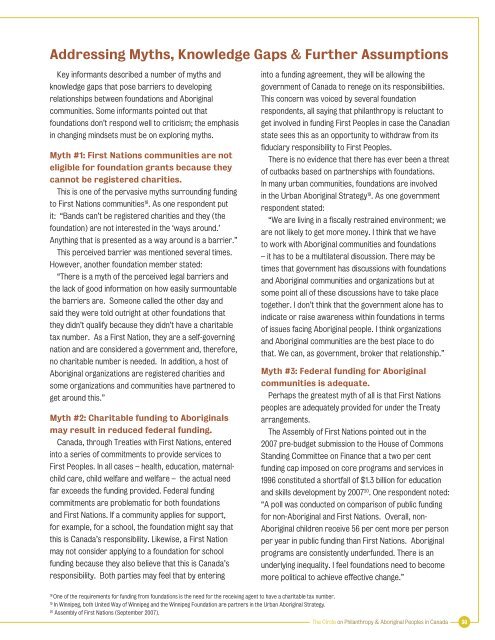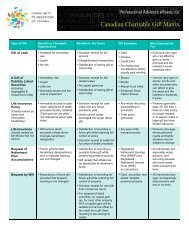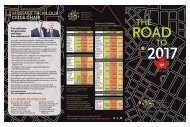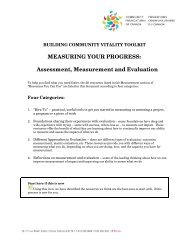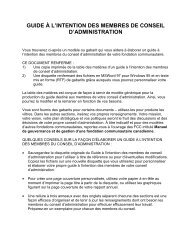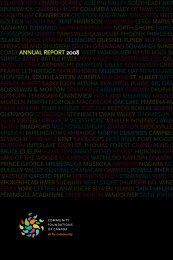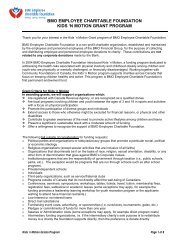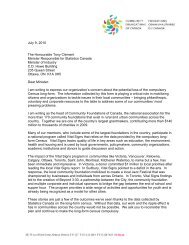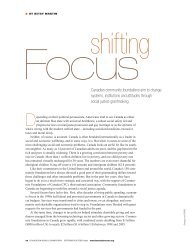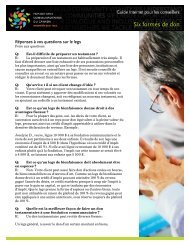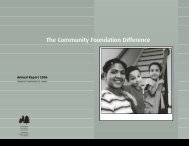Aboriginal Philanthropy in Canada: A Foundation for Understanding
Aboriginal Philanthropy in Canada: A Foundation for Understanding
Aboriginal Philanthropy in Canada: A Foundation for Understanding
Create successful ePaper yourself
Turn your PDF publications into a flip-book with our unique Google optimized e-Paper software.
Address<strong>in</strong>g Myths, Knowledge Gaps & Further Assumptions<br />
Key <strong>in</strong><strong>for</strong>mants described a number of myths and<br />
knowledge gaps that pose barriers to develop<strong>in</strong>g<br />
relationships between foundations and <strong>Aborig<strong>in</strong>al</strong><br />
communities. Some <strong>in</strong><strong>for</strong>mants po<strong>in</strong>ted out that<br />
foundations don’t respond well to criticism; the emphasis<br />
<strong>in</strong> chang<strong>in</strong>g m<strong>in</strong>dsets must be on explor<strong>in</strong>g myths.<br />
Myth #1: First Nations communities are not<br />
eligible <strong>for</strong> foundation grants because they<br />
cannot be registered charities.<br />
This is one of the pervasive myths surround<strong>in</strong>g fund<strong>in</strong>g<br />
to First Nations communities 18 . As one respondent put<br />
it: “Bands can’t be registered charities and they (the<br />
foundation) are not <strong>in</strong>terested <strong>in</strong> the ‘ways around.’<br />
Anyth<strong>in</strong>g that is presented as a way around is a barrier.”<br />
This perceived barrier was mentioned several times.<br />
However, another foundation member stated:<br />
“There is a myth of the perceived legal barriers and<br />
the lack of good <strong>in</strong><strong>for</strong>mation on how easily surmountable<br />
the barriers are. Someone called the other day and<br />
said they were told outright at other foundations that<br />
they didn’t qualify because they didn’t have a charitable<br />
tax number. As a First Nation, they are a self-govern<strong>in</strong>g<br />
nation and are considered a government and, there<strong>for</strong>e,<br />
no charitable number is needed. In addition, a host of<br />
<strong>Aborig<strong>in</strong>al</strong> organizations are registered charities and<br />
some organizations and communities have partnered to<br />
get around this.”<br />
Myth #2: Charitable fund<strong>in</strong>g to <strong>Aborig<strong>in</strong>al</strong>s<br />
may result <strong>in</strong> reduced federal fund<strong>in</strong>g.<br />
<strong>Canada</strong>, through Treaties with First Nations, entered<br />
<strong>in</strong>to a series of commitments to provide services to<br />
First Peoples. In all cases – health, education, maternalchild<br />
care, child welfare and welfare – the actual need<br />
far exceeds the fund<strong>in</strong>g provided. Federal fund<strong>in</strong>g<br />
commitments are problematic <strong>for</strong> both foundations<br />
and First Nations. If a community applies <strong>for</strong> support,<br />
<strong>for</strong> example, <strong>for</strong> a school, the foundation might say that<br />
this is <strong>Canada</strong>’s responsibility. Likewise, a First Nation<br />
may not consider apply<strong>in</strong>g to a foundation <strong>for</strong> school<br />
fund<strong>in</strong>g because they also believe that this is <strong>Canada</strong>’s<br />
responsibility. Both parties may feel that by enter<strong>in</strong>g<br />
<strong>in</strong>to a fund<strong>in</strong>g agreement, they will be allow<strong>in</strong>g the<br />
government of <strong>Canada</strong> to renege on its responsibilities.<br />
This concern was voiced by several foundation<br />
respondents, all say<strong>in</strong>g that philanthropy is reluctant to<br />
get <strong>in</strong>volved <strong>in</strong> fund<strong>in</strong>g First Peoples <strong>in</strong> case the Canadian<br />
state sees this as an opportunity to withdraw from its<br />
fiduciary responsibility to First Peoples.<br />
There is no evidence that there has ever been a threat<br />
of cutbacks based on partnerships with foundations.<br />
In many urban communities, foundations are <strong>in</strong>volved<br />
<strong>in</strong> the Urban <strong>Aborig<strong>in</strong>al</strong> Strategy 19 . As one government<br />
respondent stated:<br />
“We are liv<strong>in</strong>g <strong>in</strong> a fiscally restra<strong>in</strong>ed environment; we<br />
are not likely to get more money. I th<strong>in</strong>k that we have<br />
to work with <strong>Aborig<strong>in</strong>al</strong> communities and foundations<br />
– it has to be a multilateral discussion. There may be<br />
times that government has discussions with foundations<br />
and <strong>Aborig<strong>in</strong>al</strong> communities and organizations but at<br />
some po<strong>in</strong>t all of these discussions have to take place<br />
together. I don’t th<strong>in</strong>k that the government alone has to<br />
<strong>in</strong>dicate or raise awareness with<strong>in</strong> foundations <strong>in</strong> terms<br />
of issues fac<strong>in</strong>g <strong>Aborig<strong>in</strong>al</strong> people. I th<strong>in</strong>k organizations<br />
and <strong>Aborig<strong>in</strong>al</strong> communities are the best place to do<br />
that. We can, as government, broker that relationship.”<br />
Myth #3: Federal fund<strong>in</strong>g <strong>for</strong> <strong>Aborig<strong>in</strong>al</strong><br />
communities is adequate.<br />
Perhaps the greatest myth of all is that First Nations<br />
peoples are adequately provided <strong>for</strong> under the Treaty<br />
arrangements.<br />
The Assembly of First Nations po<strong>in</strong>ted out <strong>in</strong> the<br />
2007 pre-budget submission to the House of Commons<br />
Stand<strong>in</strong>g Committee on F<strong>in</strong>ance that a two per cent<br />
fund<strong>in</strong>g cap imposed on core programs and services <strong>in</strong><br />
1996 constituted a shortfall of $1.3 billion <strong>for</strong> education<br />
and skills development by 2007 20 . One respondent noted:<br />
“A poll was conducted on comparison of public fund<strong>in</strong>g<br />
<strong>for</strong> non-<strong>Aborig<strong>in</strong>al</strong> and First Nations. Overall, non-<br />
<strong>Aborig<strong>in</strong>al</strong> children receive 56 per cent more per person<br />
per year <strong>in</strong> public fund<strong>in</strong>g than First Nations. <strong>Aborig<strong>in</strong>al</strong><br />
programs are consistently underfunded. There is an<br />
underly<strong>in</strong>g <strong>in</strong>equality. I feel foundations need to become<br />
more political to achieve effective change.”<br />
18<br />
One of the requirements <strong>for</strong> fund<strong>in</strong>g from foundations is the need <strong>for</strong> the receiv<strong>in</strong>g agent to have a charitable tax number.<br />
19<br />
In W<strong>in</strong>nipeg, both United Way of W<strong>in</strong>nipeg and the W<strong>in</strong>nipeg <strong>Foundation</strong> are partners <strong>in</strong> the Urban <strong>Aborig<strong>in</strong>al</strong> Strategy.<br />
20<br />
Assembly of First Nations (September 2007).<br />
The Circle on <strong>Philanthropy</strong> & <strong>Aborig<strong>in</strong>al</strong> Peoples <strong>in</strong> <strong>Canada</strong> 30


